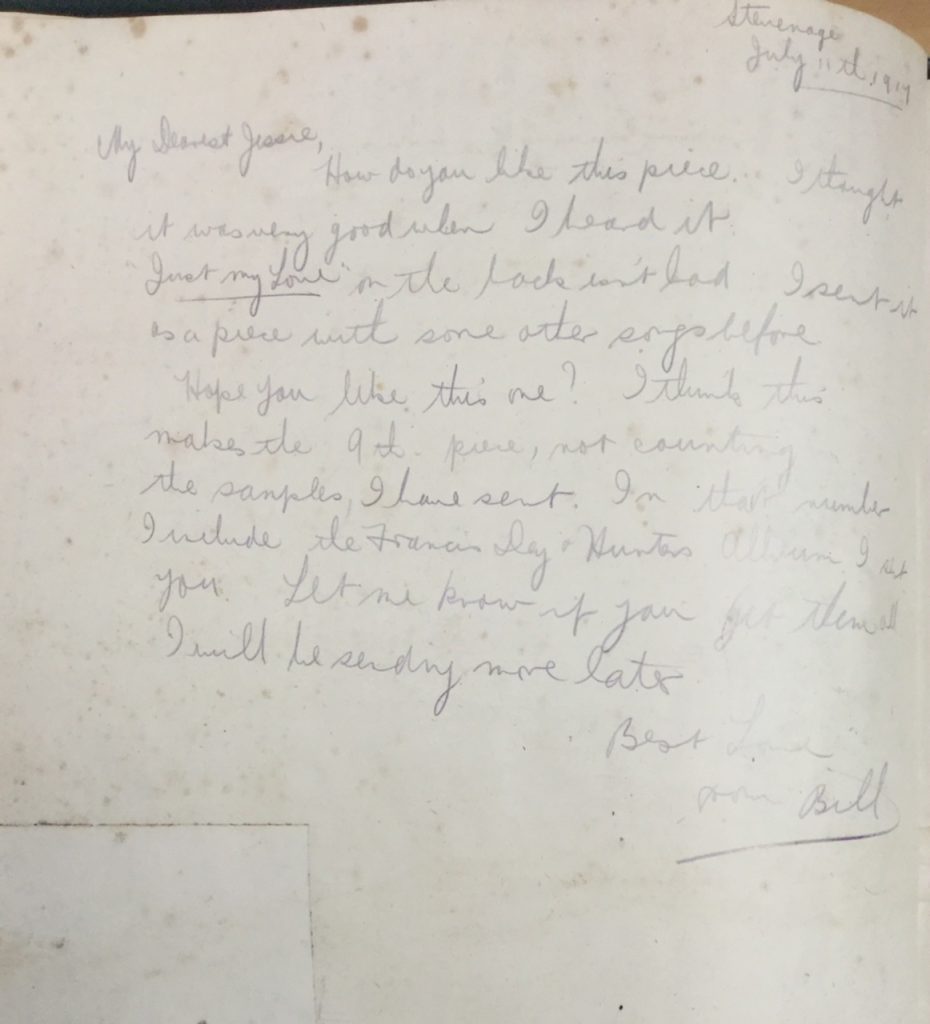Post researched and written by Amanda Mills, Curator Music and AV
The Hocken sheet music collection houses some interesting titles and volumes, including a number of owner-bound volumes, which are, on the surface, intriguing collections of random choices of sheet music. We collect these from a number of places including auctions and sales, with a handful of volumes donated to us. The purpose of owner-bound volumes was to collate collected music, keeping it tidy and in good condition, and easier to use on a piano stand. Cultural capital was also important. Many had gilt lettering and leather binding, so were attractive to display. Also (like a contemporary music collection), they displayed the owner’s tastes in sheet music, and the subjective choices and organisation are displayed by the indexing, which was often hand-written.
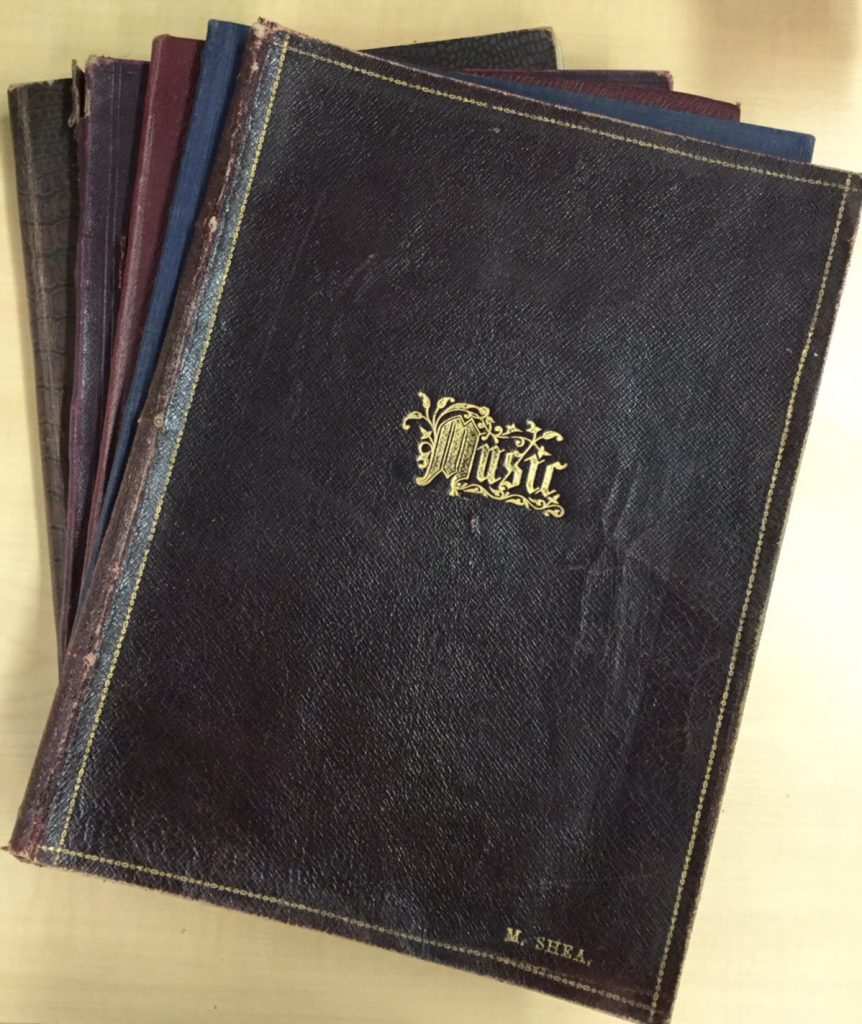 These volumes tell stories of what was fashionable in music at the time, and available to purchase locally from dealers, although all volumes included sheet music that was purchased overseas, and therefore not widely available here. The content throughout all the volumes is a mix of song (piano-and-vocal), and music (piano only), and much of this is related to dance. However, Aline Maxwell-Scott, writing about jazz-age owner-bound volumes in Australasia, thinks women’s owner-bound volumes were more likely to include songs than men’s[1], although our volumes belonging to William Larnach show a substantial number of piano-and-vocal songs.
These volumes tell stories of what was fashionable in music at the time, and available to purchase locally from dealers, although all volumes included sheet music that was purchased overseas, and therefore not widely available here. The content throughout all the volumes is a mix of song (piano-and-vocal), and music (piano only), and much of this is related to dance. However, Aline Maxwell-Scott, writing about jazz-age owner-bound volumes in Australasia, thinks women’s owner-bound volumes were more likely to include songs than men’s[1], although our volumes belonging to William Larnach show a substantial number of piano-and-vocal songs.
The practice of owner-binding sheet music dates to the nineteenth century, and is linked predominantly to both the mass publishing of sheet music, and to domestic amateur music making. This was largely the realm of women, as they were the primary providers of musical entertainment in the home, according to Maxwell-Scott[2], and she notes that playing the piano was an accomplishment that enhanced marriage prospects[3]. The female acquisition of musical skills maintained the social values of the developing middle classes, which was especially true for the Antipodes, where applying European cultural values to the uncivilised environs of the colonies was valued greatly. The piano was even considered “a kind of gigantic hearth God, to be placated by polish and performance, its altar covered in lace and candles”[4]. It was also women who drove the nineteenth-century market for sheet music and popular songs, and increased demand led to the rise in the production of this music, and expansion of the music industry.
The overall content of owner-bound volumes is eclectic, with different genres represented – sentimental song, classical piano pieces, operatic arrangements, comic bawdy numbers, and songs relating to military or war subjects. Many were popular songs of the day. There is also the aesthetic nature of sheet music covers to consider, as many are beautiful, and still in extremely good condition. Over time, owner-bound volumes became more scarce, with a drop in number from the 1920s, correlating with the rise of the gramophone and the 78rpm disc.
The earliest owner-bound volumes in Hocken’s sheet music collection bear William Larnach’s name embossed on the cover, and date to around the 1880s. Although there is no date for the binding, it is likely to have occurred relatively quickly, as a way to collate the music, and also to signify cultural status. Larnach’s volumes are interesting, containing many songs from Sheard’s comic song annuals which were published overseas, although one piece, ‘The Old Flag’, was published in Dunedin by G.R. West, at 18 Princes Street. Unlike later owner-bound volumes, there is not much information annotated on the sheets, but the titles make for interesting reading!
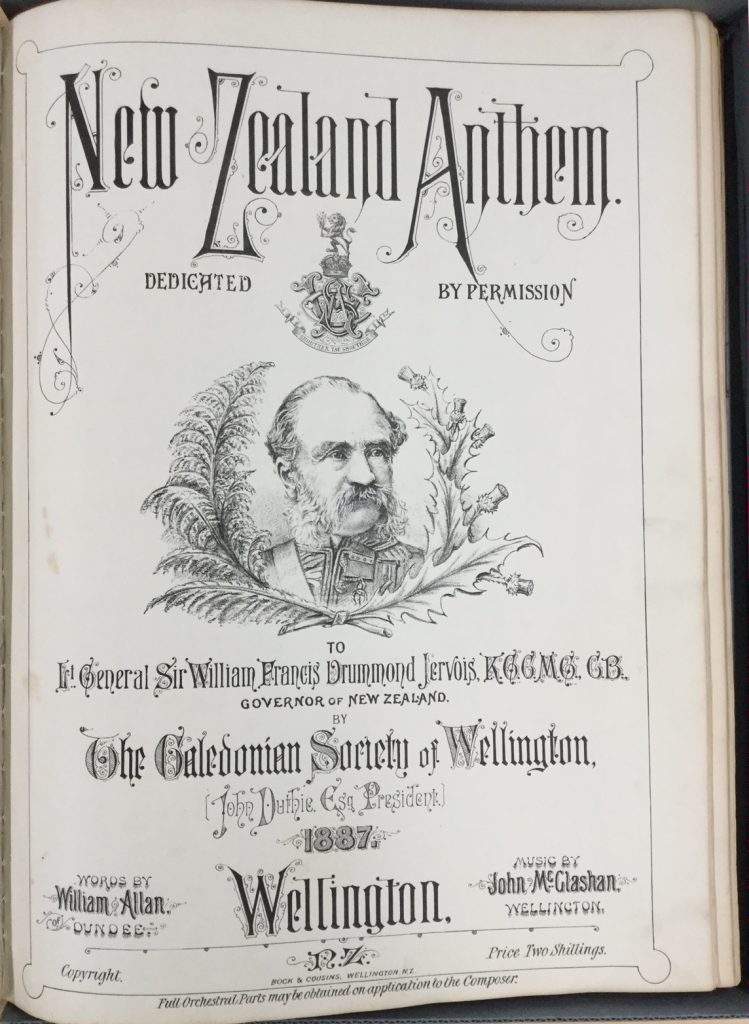
Title from William Larnach’s owner-bound volume. ‘New Zealand Anthem: Dedicated by permission to Lt. General Sir William Francis Drummond Jervois K.G.C.M.G., C.B.’ by William Allan and John McGlashan. Hocken Sheet Music Collection.
Owner-bound volumes don’t always include local material, focusing on predominantly English or American titles. There are some exceptions, especially in one volume belonging originally to Lucy Maude Bayley, which features some rare local sheets by Charles H. Russell, published by Charles Begg in Dunedin. However, even if the music is not from New Zealand, the dealers were, and dealers’ stamps tell you what music was available at what dealer, with stamps for Begg’s and Terry’s, and later, Muriel Caddie (among others) frequently appearing. Also, these owner-bound volumes were predominantly collected by local individuals: their initials regularly appear on the front of the volumes, and the sheets are annotated with their names, and (often) addresses, so we can try and trace their lives. However, due to the sheets being trimmed for binding, these details are often lost, or at least severely cut, making it harder to locate owners.
Some volumes stand out and tell stories through the addresses, and annotations given. Harry Kelk’s owner-bound volume is one. Kelk (a teacher) emigrated to New Zealand from England in the 1870s, aged 16. His owner-bound volume has music sheets collected over a number of years, and although they have no dates printed on them, a couple have the dates hand-written on them. One of the later sheets (‘The Mikado Quadrilles’) has the inscription ‘H. P. Kelk, from his aunt Ellen, 1906’, while others have dates in the 1880s. There are some interesting inscriptions too – ‘Myosotis’ reads “Don’t forget the night you heard this first! Never!” and “A thing of beauty is you forever.” These sheets are all piano music, and predominantly waltzes.
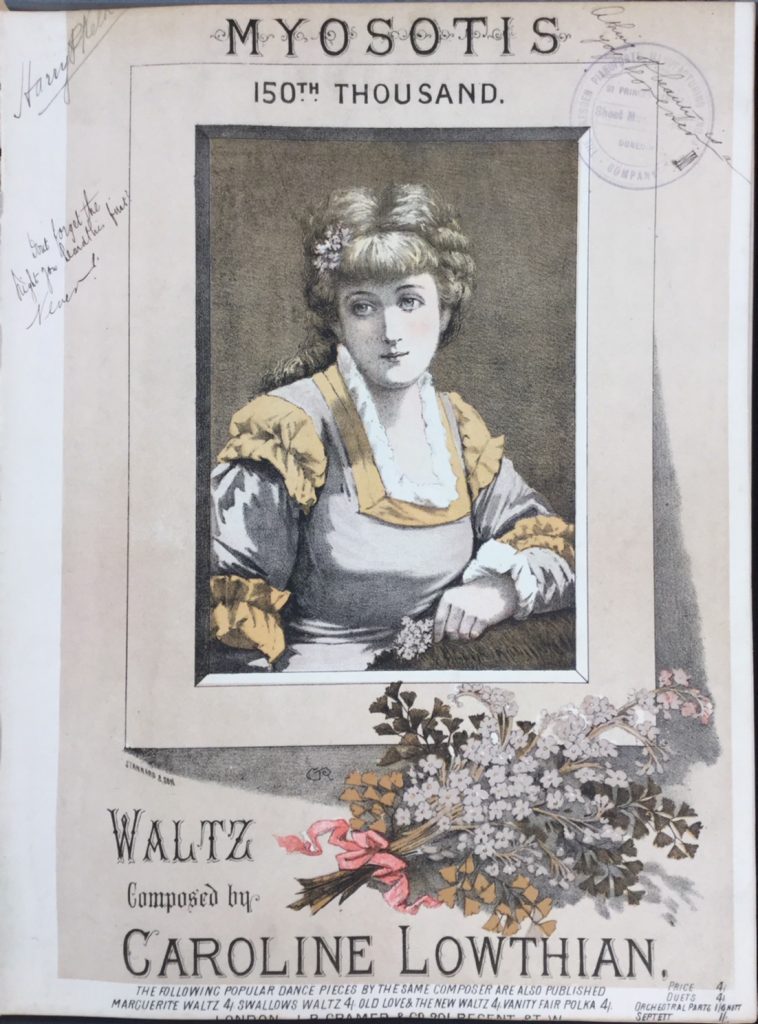
Title from Harry Kelk’s owner-bound volume. ‘Myosotis’ by Caroline Lowthian. Hocken Sheet Music Collection.
Another recently-acquired owner-bound volume was originally compiled by Lucy Maude Mary Bayley, who was born in 1869 to Frederick and Lucy Bayley. Her volume features some interesting sheets, mostly piano music: polkas, airs, mazurkas, melodies, and studies. Four of these music sheets were locally published – ‘The Daily Times Mazurka’ (a polish folk dance in triple meter), was published and available from Kelsey’s (who were taken over by Begg’s in 1883), ‘The Colonial Mazurka’, published by G. R. West, and two rare pieces by Charles H. Russell – ‘Fern Leaves’, and ‘The Silvery Spray Mazurka’, both published by Beggs. While most of these songs are undated, we can get an estimated publishing date, as Lucy Bayley annotated some titles with a (purchase?) date.
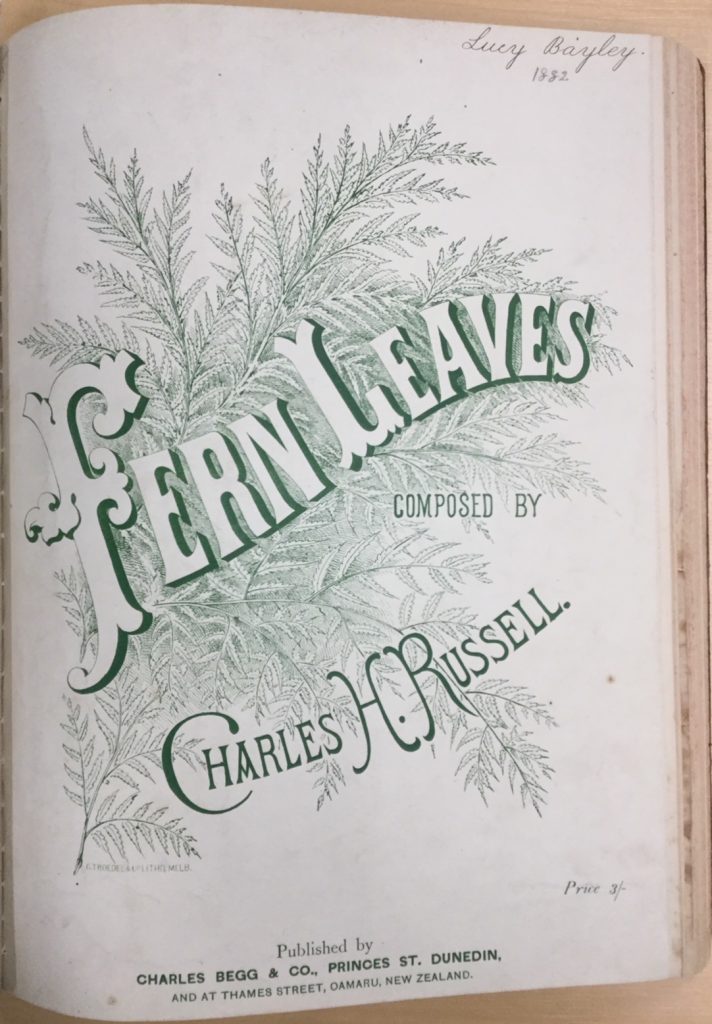
Title from Lucy Maude Bayley’s owner-bound volume. ‘Fern Leaves’ by Charles H. Russell. Hocken Sheet Music Collection.
Finally, the three owner-bound volumes of Jessie Bell McLaren provide a slightly more modern comparison. McLaren was born around 1896 to David and Christina McLaren of 15 Crown St, North East Valley (her address is annotated on one of the music sheets). Her three volumes of sheets, titled Selections and Songs on the cover, still have their binders’ stamps, which identify Whitcombe and Tombs on Princes Street as the binder. These volumes are a diverse collection of mostly popular songs from theatre shows, but include a number of piano-only pieces, mainly waltzes and foxtrots. McLaren dated these pieces, so we can see the acquisition date, which was during the First World War. There are a few war-related sheet music titles, with some directly related to theatre productions about the Great War. While many of these titles were purchased in Dunedin or in other New Zealand centres (dealers stamps give the location), a number were sent to her from England. Written on the back of one sheet is a letter from a loved one, Bill, who sent the sheet from Stevenage, England during that time. This could be a co-incidence, but Jessie Bell McLaren married chemist William Francis Stanley Pollock in 1922, moving to Highgate. Is he the same Bill who wrote the letter?
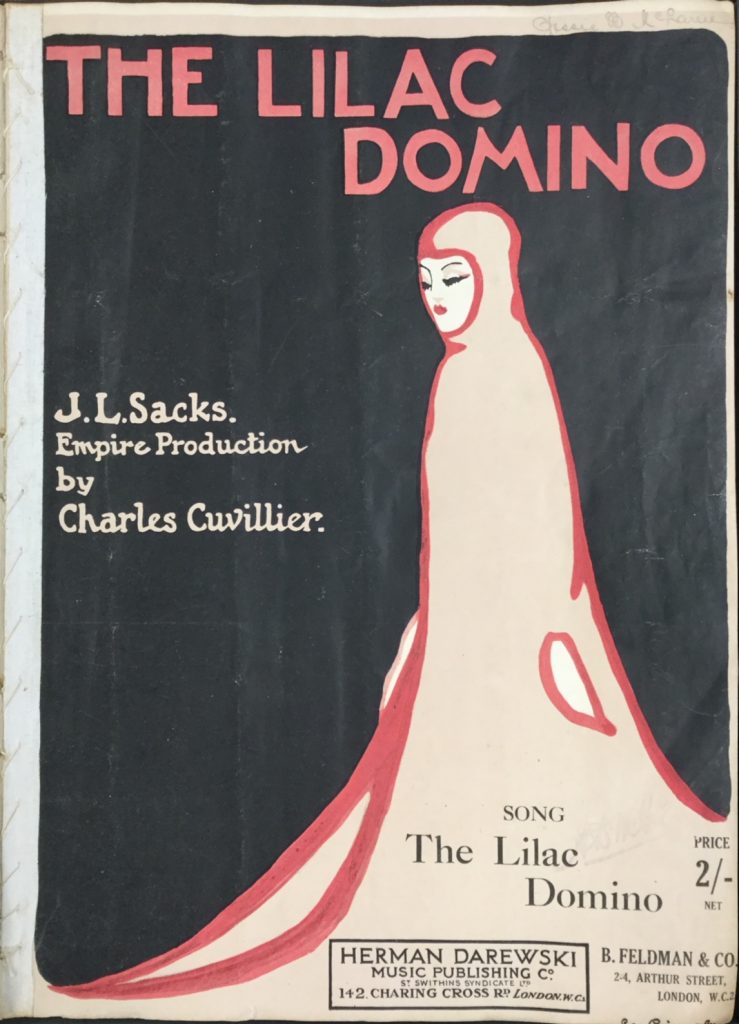
Title from Jessie Bell McLaren’s owner-bound volumes. ‘The Lilac Domino’ by Charles Culliver. Hocken Sheet Music Collection.
The remaining owner-bound volumes in Hocken’s sheet music collections date between the late 1800s and the 1950s, and all have thought-provoking selections of international, and locally-produced music. Not all are listed on the University’s Library Search|Ketu online public access catalogue, but we are working to make these volumes, and their contents, searchable. However, they can all be viewed in our reading room – please come and talk to our Curator, Music and AV if you would like to view them.
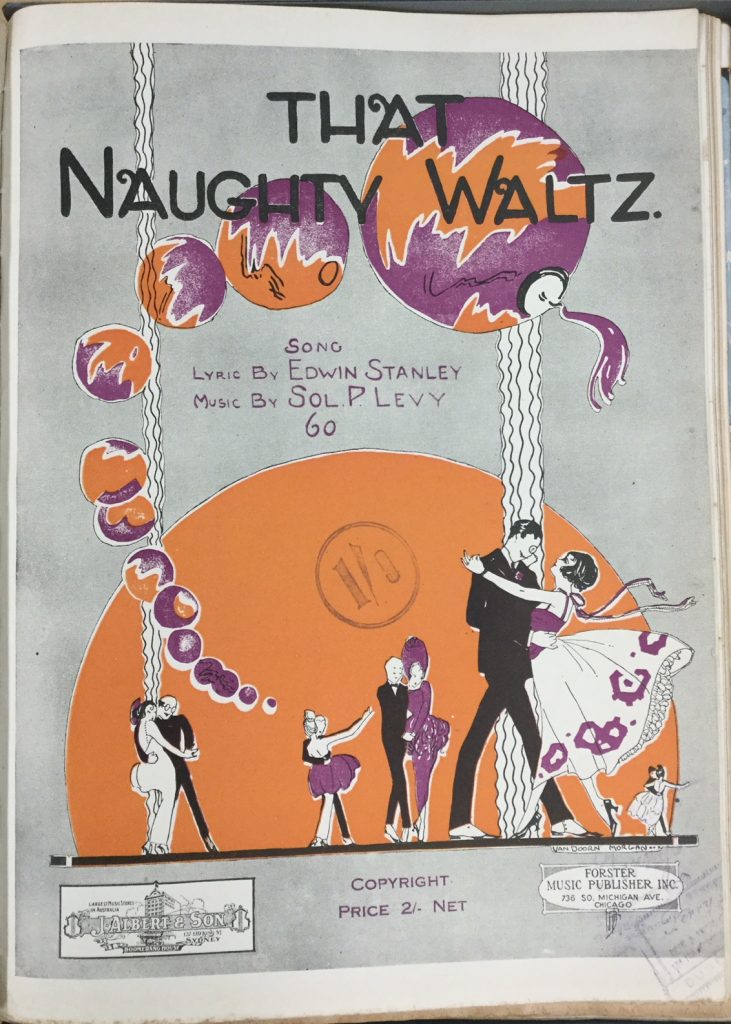
Title from Jessie Bell McLaren’s owner-bound volumes. ‘That Naughty Waltz’ by Edwin Stanley and Sol. P Levy. Hocken Music Collection. Note the Dunedin dealer’s stamp in the lower right hand corner, and that the sheet has been trimmed.
[1] Maxwell-Scott, 2016, p 192.
[2] Maxwell-Scott, 2016, p 189.
[3] Maxwell Scott, 2016, p 191.
[4] Crisp, L. quoted in Maxwell-Scott, 2016, p 191.


